Yuliang Zhu
DUN-SRE: Deep Unrolling Network with Spatiotemporal Rotation Equivariance for Dynamic MRI Reconstruction
Jun 12, 2025Abstract:Dynamic Magnetic Resonance Imaging (MRI) exhibits transformation symmetries, including spatial rotation symmetry within individual frames and temporal symmetry along the time dimension. Explicit incorporation of these symmetry priors in the reconstruction model can significantly improve image quality, especially under aggressive undersampling scenarios. Recently, Equivariant convolutional neural network (ECNN) has shown great promise in exploiting spatial symmetry priors. However, existing ECNNs critically fail to model temporal symmetry, arguably the most universal and informative structural prior in dynamic MRI reconstruction. To tackle this issue, we propose a novel Deep Unrolling Network with Spatiotemporal Rotation Equivariance (DUN-SRE) for Dynamic MRI Reconstruction. The DUN-SRE establishes spatiotemporal equivariance through a (2+1)D equivariant convolutional architecture. In particular, it integrates both the data consistency and proximal mapping module into a unified deep unrolling framework. This architecture ensures rigorous propagation of spatiotemporal rotation symmetry constraints throughout the reconstruction process, enabling more physically accurate modeling of cardiac motion dynamics in cine MRI. In addition, a high-fidelity group filter parameterization mechanism is developed to maintain representation precision while enforcing symmetry constraints. Comprehensive experiments on Cardiac CINE MRI datasets demonstrate that DUN-SRE achieves state-of-the-art performance, particularly in preserving rotation-symmetric structures, offering strong generalization capability to a broad range of dynamic MRI reconstruction tasks.
Unleashing Dynamic Range and Resolution in Unlimited Sensing Framework via Novel Hardware
Oct 26, 2024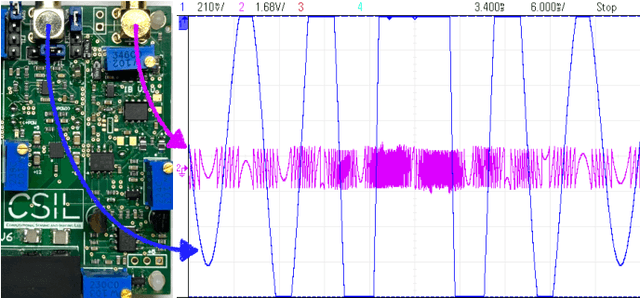

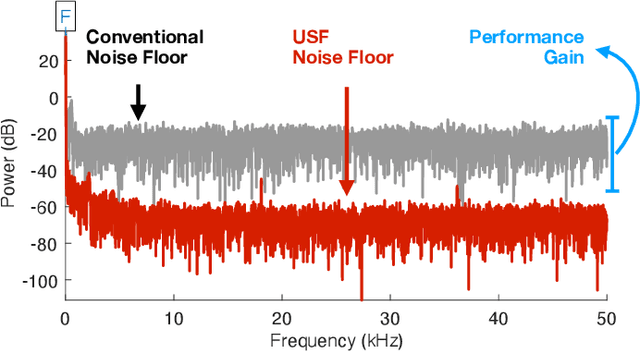
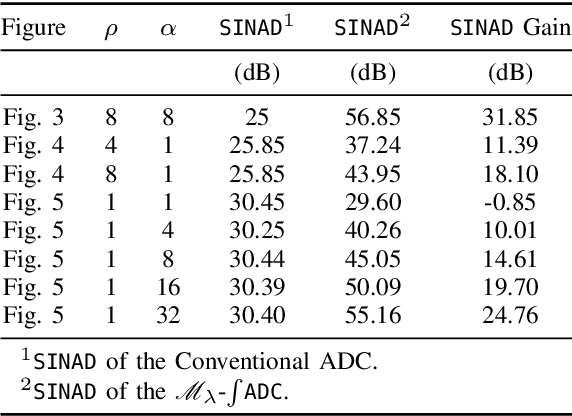
Abstract:Conventional digitization based on the Shannon-Nyquist method, implemented via analog-to-digital converters (ADCs), faces fundamental limitations. High-dynamic-range (HDR) signals often get clipped or saturated in practice. Given a fixed bit budget, one must choose between minimizing quantization noise or accommodating HDR inputs. The Unlimited Sensing Framework (USF) eliminates saturation by incorporating nonlinear folding in analog hardware, resulting in modulo signals. Quantizing or digitizing modulo signals enables low quantization noise as the modulo representation maps HDR signals into low-dynamic-range (LDR) samples. In the context of USF, the core innovation of this paper is a novel, low-cost, integrator-based efficient modulo ADC hardware implementation that imposes no restrictions on folding rates, enabling significantly HDR capture. The feasibility of this design is demonstrated by hardware experiments showcasing clear advantages across different quantitative performance metrics. These include capturing HDR signals with a 60-fold increase in dynamic range, achieving up to 5 Effective Number of Bits (ENOBs), and improving Signal-to-Noise and Distortion (SINAD) by 30 dB.
Sub-Nyquist USF Spectral Estimation: $K$ Frequencies with $6K + 4$ Modulo Samples
Sep 24, 2024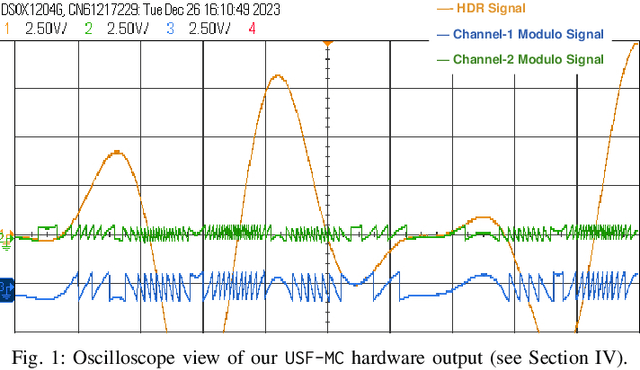
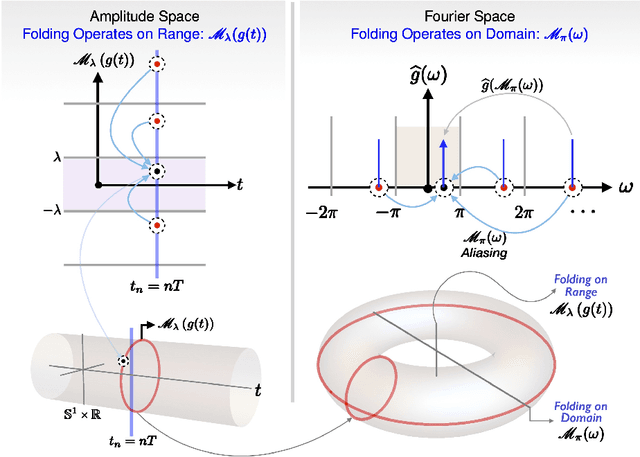
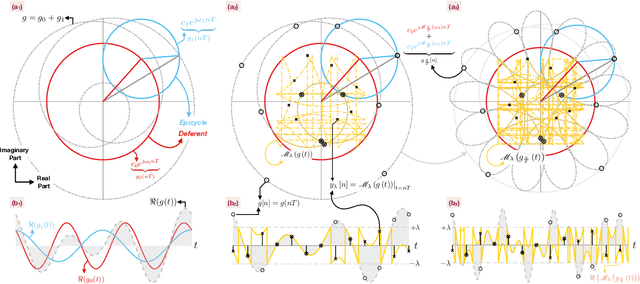
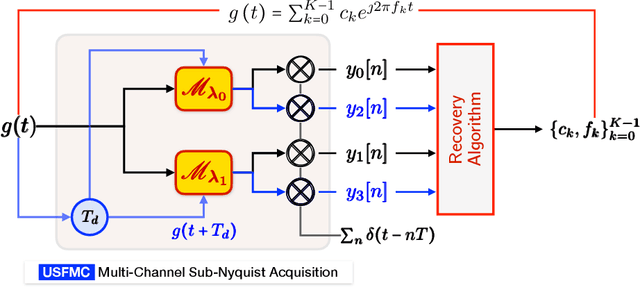
Abstract:Digital acquisition of high bandwidth signals is particularly challenging when Nyquist rate sampling is impractical. This has led to extensive research in sub-Nyquist sampling methods, primarily for spectral and sinusoidal frequency estimation. However, these methods struggle with high-dynamic-range (HDR) signals that can saturate analog-to-digital converters (ADCs). Addressing this, we introduce a novel sub-Nyquist spectral estimation method, driven by the Unlimited Sensing Framework (USF), utilizing a multi-channel system. The sub-Nyquist USF method aliases samples in both amplitude and frequency domains, rendering the inverse problem particularly challenging. Towards this goal, our exact recovery theorem establishes that $K$ sinusoids of arbitrary amplitudes and frequencies can be recovered from $6K + 4$ modulo samples, remarkably, independent of the sampling rate or folding threshold. In the true spirit of sub-Nyquist sampling, via modulo ADC hardware experiments, we demonstrate successful spectrum estimation of HDR signals in the kHz range using Hz range sampling rates (0.078\% Nyquist rate). Our experiments also reveal up to a 33-fold improvement in frequency estimation accuracy using one less bit compared to conventional ADCs. These findings open new avenues in spectral estimation applications, e.g., radars, direction-of-arrival (DoA) estimation, and cognitive radio, showcasing the potential of USF.
SRE-CNN: A Spatiotemporal Rotation-Equivariant CNN for Cardiac Cine MR Imaging
Sep 13, 2024Abstract:Dynamic MR images possess various transformation symmetries,including the rotation symmetry of local features within the image and along the temporal dimension. Utilizing these symmetries as prior knowledge can facilitate dynamic MR imaging with high spatiotemporal resolution. Equivariant CNN is an effective tool to leverage the symmetry priors. However, current equivariant CNN methods fail to fully exploit these symmetry priors in dynamic MR imaging. In this work, we propose a novel framework of Spatiotemporal Rotation-Equivariant CNN (SRE-CNN), spanning from the underlying high-precision filter design to the construction of the temporal-equivariant convolutional module and imaging model, to fully harness the rotation symmetries inherent in dynamic MR images. The temporal-equivariant convolutional module enables exploitation the rotation symmetries in both spatial and temporal dimensions, while the high-precision convolutional filter, based on parametrization strategy, enhances the utilization of rotation symmetry of local features to improve the reconstruction of detailed anatomical structures. Experiments conducted on highly undersampled dynamic cardiac cine data (up to 20X) have demonstrated the superior performance of our proposed approach, both quantitatively and qualitatively.
 Add to Chrome
Add to Chrome Add to Firefox
Add to Firefox Add to Edge
Add to Edge